This Ivy League wages hand-to-leaf combat against an English strangler
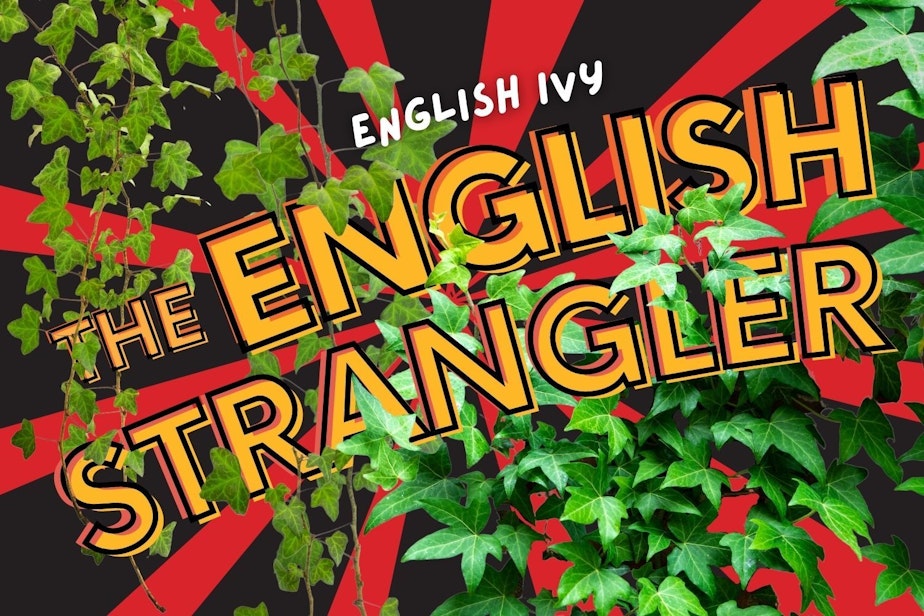
Up and down the West Coast, English ivy grows where it was never meant to.
The European vine overruns yards and quickly climbs walls and trees. It’s one of the most successful and problematic invaders of this continent – a widespread killer of native plants and the species that rely on them.
But fans of native ecosystems are fighting back.
In suburban Edmonds, Washington, a group of volunteers has taken matters into their own hands. They call themselves the Edmonds Ivy League.
There are no hallowed halls or tweed-jacketed professors in this ivy league. Instead, there’s manual labor in the dirt.
“We're eradicating the evil English ivy,” league member Lisa Villanueva said during a break from reeling in long green runners snaking across the forest floor. “Because it eventually will choke out the trees.”
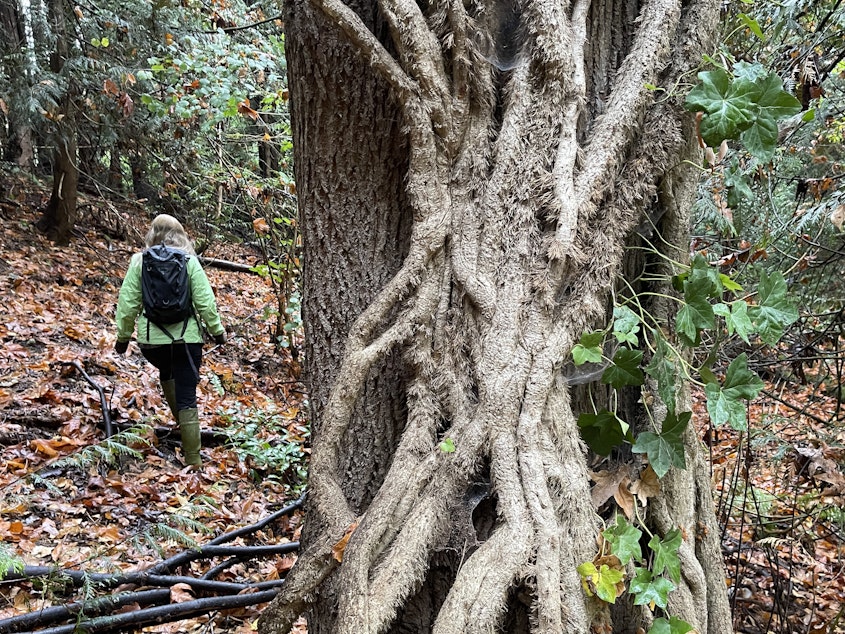
This story is Part 2 of our series on invasive species in Washington state: “KUOW's League of Murder Creatures.”
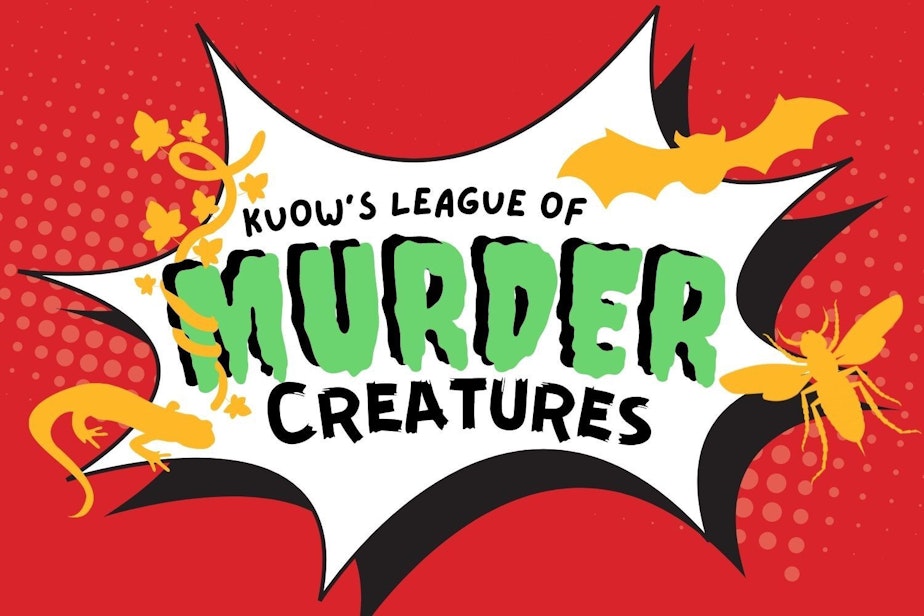
E
uropean settlers brought ivy to America as early as 1727. For nearly three centuries, gardeners and landscapers have planted it to provide quick, low-maintenance, evergreen foliage that tolerates shade or sun.
With its sprawling tendencies and with the assistance of berry-loving birds, ivy has seemingly embarked on a mission to take over a continent.
Its bluish-black berries, toxic to humans and to some birds, are eaten and its seeds spread by birds including robins, Steller’s jays, and European starlings.
While ivy has overgrown its welcome in much of the United States, it has become most abundant in the mild climes of the Northwest.
“It is considered a threat to nearly all forest types in the Pacific Northwest coastal area below 3,000 feet,” according to the U.S. Forest Service.
“This evergreen climbing vine engulfs whatever is in its path, including shrubs, buildings, or old-growth forest,” according to Olympic National Park’s website.
In places, ivy grows so thick, it’s like a shiny wall-to-wall carpet. These near-monocultures are sometimes called “ivy deserts.”
Ivy can climb into treetops, where the added weight and “sail area” of the extra foliage can cause trees to topple in a windstorm. Ivy whackers once removed an estimated 2,100 pounds of ivy leaves, stems, and woody roots from a single tree in Olympic National Park.
While many vines have to gradually spiral themselves around other plants’ stems to dominate their victims, ivy exudes a nanoparticle glue that allows it to quickly climb up and over obstacles living or dead—even smooth, vertical walls.
Researchers are studying ivy’s spherical nanoparticles (think microscopic glue balls) in hopes of creating high-strength adhesives for possible medical or military use.
In short, English ivy is a tough customer, and any would-be ivy eradicators have their work cut out for them.
“Its will to live is very strong,” said Edmonds Ivy League founder Mikael Öhman.
(A note to any plant nerds out there: Two closely related ivy species (English ivy [Hedera helix] and Irish or Atlantic ivy [Hedera hibernica]) are hard to tell apart and are commonly lumped together under the term “English ivy.” This story lumps them, too.)

T
he Edmonds Ivy League meets Saturday mornings in Southwest County Park, the largest protected area in the Seattle suburb of Edmonds. The sylvan park encompasses 115 acres of woods and hiking trails.
“It doesn't feel like you're in a city,” said Öhman, who has been trail running there since 2005. “It's like you're alone out there in nature, in the forest. Feels like being up in the foothills.”
But there’s a life-or-death battle going on in those peaceful woods as ivy and another British aggressor, the painfully spiky English holly, try to shade out or choke off native plants.
Öhman and the other ivy leaguers have been dedicating their Saturday mornings to helping the forest defend itself from the invaders.
“If we leave this park to its own devices, it's going to destroy itself, or the invasives are going to destroy it,” Öhman said. “The ivy is going to grow up into the trees, strangle them, pull them down. And then the holly’s going to come in.”
Before he started the ivy league, he did guerrilla trail maintenance and weed removal in the park on his own.
One time, he brought a chainsaw in to remove trees that had fallen across a trail in a windstorm.
“When I came out of the park again, there were two Snohomish County Ranger trucks waiting for me at the sidewalk,” Öhman said. “One of the rangers just said, ‘Stop. Put down the chainsaw and take a step forward,’ and I thought, ‘Oh my God, I'm screwed.’”
But Öhman explained what he was doing, then took the rangers up the trail to show them his handiwork.
“And they asked me if I would consider becoming a park ambassador,” Öhman said. “And I said, ‘Yes.’”
Now, volunteers gather weekly in the park with work gloves and hand tools to help native plants like Oregon grape and salal reclaim a bit of their ivied turf.
Even a tiny, broken-off chunk of ivy root can resprout into a brand-new plant.
“Even after you pull it off the tree, it stays alive for a while,” said ivy leaguer Tom Bednar. “It tries like hell to get its roots down in the ground and then keep going.”
When their work takes them too far from a trailhead to carry uprooted vines back out of the park, the ivy leaguers build platforms of fallen tree branches: places for yanked vines to decompose without springing back from the dead.
So many agencies and volunteers in the Northwest have put in so much effort to fight ivy that the field has developed its own vocabulary. To make a “survival ring,” ivy fighters cut down tree-climbing ivy roots at chest height and clear a five-foot radius of ivy from the ground surrounding the tree. In severely infested areas, the technique of peeling back an ivy carpet off the ground is known as “burrito rolling.”
It’s an uphill battle. Birds can deliver new ivy seeds from near or far at any time, and there’s an unending supply of those seeds.
People throughout the Northwest (and much of North America) keep growing ivy intentionally in their yards.
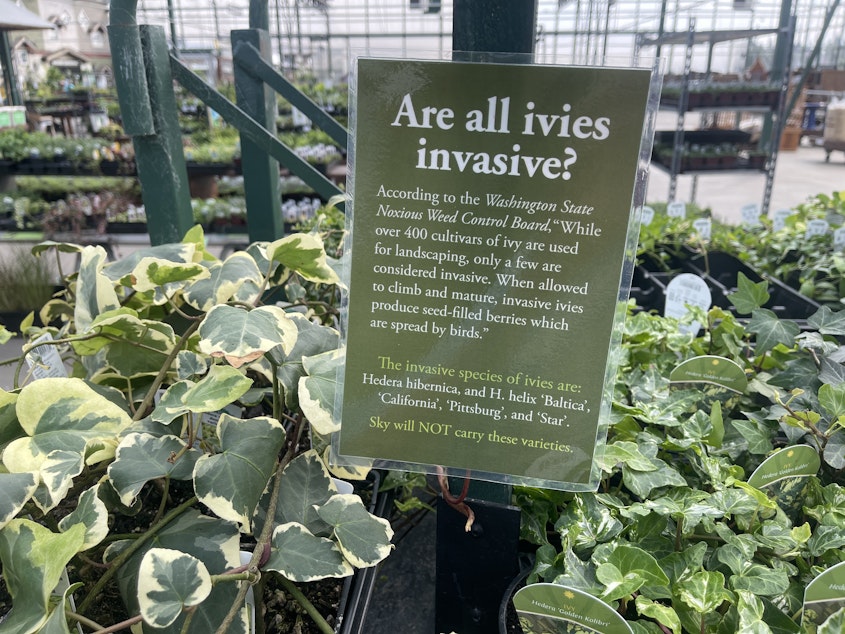
“
A lot of people do buy it because it's such a fast spreader and can fill up an area that's hard to grow plants in very quickly, in particular in the shade,” said Judy Boersema, the perennial buyer at Sky Nursery in Shoreline, just south of Edmonds.
She showed off the display of ivy varieties for sale there, with a sign quoting the state's noxious weed control board that only a handful of ivy cultivars out of more than 400 are considered invasive.
“And we simply don't buy them,” Boersema said. “We don't buy them. We don't sell them.”
Other sellers are less discerning. You can buy the invasive ivies at big-box retailers, nurseries, and online.
Some plant specialists say even the ivies deemed non-invasive ivies can hybridize with the invasive ones to create badly behaved offspring.
The safest bet for helping native species is to avoid buying any ivy.
“A good rule for landowners is, ‘If it’s ivy, it’s a problem to be managed,’” according to the Clackamas Soil and Water Conservation District near Portland, Oregon.
Oregon prohibited the sale of English ivy in 2010. The city of Kirkland, Washington, outlawed planting the ivy and a dozen other unwelcome plants on private property in 2008.
But in most of Washington, English ivy is a “Class C noxious weed” – selling, buying, or growing it is frowned upon, but perfectly legal.
In addition to its noxious weed lists, Washington state has a “quarantine list” of more than 100 invasive plant species that are illegal to buy, sell, transport, or plant. Anyone can petition the Washington State Department of Agriculture to add a species to the list. An agency spokesperson said no one has ever done so for English ivy.
I asked the Edmonds Ivy Leaguers if they knew that their sworn enemy was still being sold at garden centers and nurseries in Washington.
“That's weird,” Öhman said.
“Not like there isn't enough to go around already,” Bednar added.
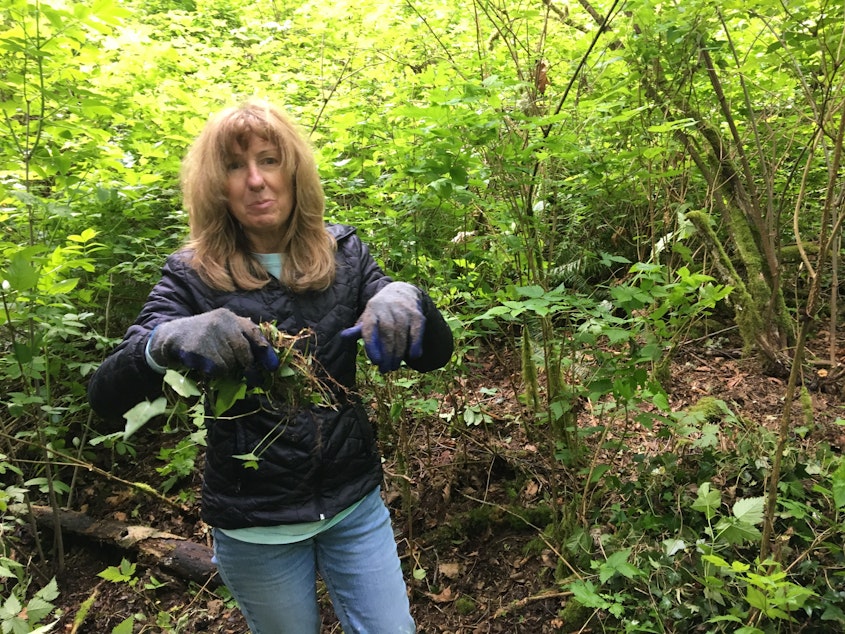
B
ack at Southwest County Park, the ivy leaguers said they initially got involved to help save a beloved pocket of nature in their backyards.
“I use these woods almost every day in good weather,” Bednar said during a break from wrestling a stubborn root wad of a holly tree out of the ground. “So, how could I not give back, you know?”
They soon found that digging up roots and yanking vines has been good for them as well.
“I guess it started out with, ‘I just want to make the park better,’” Öhman said. “But now it's kind of a relief valve.”
“Especially over the last couple years, when the world's just gone crazy,” Lisa Villanueva said.
The group started attacking the park’s green invaders monthly. Then the Covid pandemic hit.
“And there was literally nothing else to do, but you could be outside,” Villanueva said.
They started going every week, grateful for the chance to be with other people and forget the troubles of the world for a few hours. Not to mention the tangible satisfaction of reeling in long vines, almost like reeling in a big fish.
“We like each other an awful lot,” Bednar said. “We have good conversations. Enjoying each other’s company and doing good work at the same time, it’s really cool.”
“We definitely don't all agree on things,” Villanueva said. “But we just, you know, these are our people.”
Even now that many pre-pandemic activities have resumed, they’re still going weekly into the ivy-filled woods.
Öhman estimates the small group of volunteers has cleared weeds from about a tenth of the park. The ivy leaguers joke that they’re on a 30-year plan to liberate the entire county park of its botanical bullies.
“Yeah,” Öhman said. “I think we definitely can win this."

King County provides a list of native plant alternatives to ivy, whether you’re looking for a ground cover or a climbing vine.
This story is Part 2 of our series on invasive species in Washington state: “KUOW's League of Murder Creatures.”

